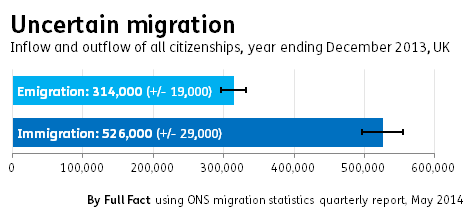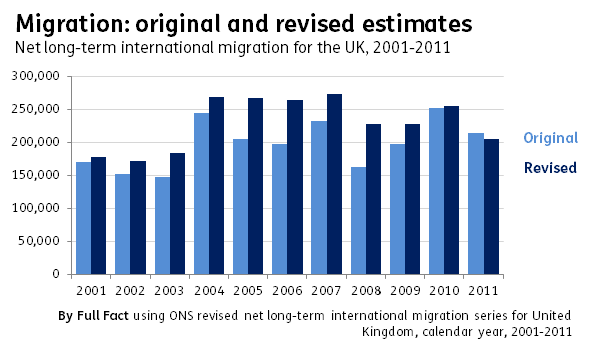How reliable are migration figures?
- Immigration and emigration are primarily measured using the International Passenger Survey (IPS), based on interviewing willing passengers at various UK ports.
- It's a small sample and reliant on passengers reporting their intentions honestly. Headline estimates of net migration are only considered accurate to within plus or minus 35,000, although they're considered better when viewed over the long term.
- The government is facing calls to improve the estimates, for instance by using the border systems programme (formerly 'e-borders') as a supplement to the survey data.
Needle in a haystack sample
Annual net migration of 212,000 people - measured mainly using the International Passenger Survey and other sources - amounts to a fraction of the number who come in or out on an average day.
As the Chair of the UK Statistics Authority, Sir Andrew Dilnot, has pointed out, net migration is the relatively small difference between two relatively large numbers, and both sets of figures are uncertain.
That's why individual estimates are considered accurate only to within plus or minus 35,000, although he points out that viewed over time they seem fairly consistent.
The statisticians who conduct the survey interview around 700,000 - 800,000 willing passengers, including around 5,000 migrants. That makes up the starting point for our estimates of migration.
To make these estimates twice as accurate — so that 19 times out of 20 they are within 17,000 of the correct figure — you would need to quadruple the sample size to 3.2 million. MPs were told in 2013 that would cost £15m but the Chair of the Committee commented: "I think that would be very bad value for money."
International Passenger Survey currently "best available measure", but there are calls for improvements
Migration estimates based on the International Passenger Survey are considered the "best available measure" of net migration "given the existing statistical sources", according to the UK Statistics Authority. This doesn't mean that everyone's satisfied with it. Far from it.
The survey itself was originally designed as a survey of tourism and travel, but it has since come to be used for migration estimates.
"Little better than a best guess."
That was the view of the headline net migration estimates taken by the Public Administration Select Committee (PASC) in 2013. More recently the Chair of that Committee has described the sources as:
"not adequate for understanding the scale and complexity of modern migration flows, despite attempts in recent years to improve their accuracy and usefulness."
The UK Statistics Authority has also commented that, while the statistics are "probably accurate enough" in a longer-term perspective, more reliable estimates in the short-term - for instance in order to assess the government's net migration target - would be helpful.
That isn't to say the figures haven't seen some improvement over recent years, A 2006 taskforce led to an improvement programme, which was reviewed by the Statistics Authority in 2009, 2011 and again last year. This includes changes to the survey design, how other data is used to test and improve the conclusions and how the data is published.
Earlier this year, the Office for National Statistics (ONS) produced a review using census data revealing that, in part because of sampling too few airports, the International Passenger Survey had underestimated net migration between 2001 and 2011 by 346,000.
The alternatives
A number of alternative or additional sources have been suggested. The government's 'eBorders' project (now called the 'Border Systems Programme') - which is designed to collect data on passenger movements - has been recommended by MPs as a product that can add extra information to existing survey data.
It's not expected to fully replace the survey because, among other things, migration estimates only include people changing residence for at least a year, which means the intentions of the visitors need to be measured or there needs to be a delayed data-matching exercise to identify long-term migrants when they leave the UK. The government also hopes to use the information for enforcement purposes.
Another option recommended is to introduce a new large face-to-face survey of existing migration, which the Home Office reviewed the feasibility of in 2011. However this option isn't currently favoured by the government.
- This spotlight incorporates some of our coverage from last year on the accuracy of migration statistics and how we can improve them.
- A broad introduction to how migration estimates work, including definitions of some of the key terms is available via the ONS website.
- For a thorough history on the International Passenger Survey, its design and the changes that have been made, the ONS has this background guide.
- For a more detailed examination of the methodology behind how the survey is carried out, the ONS has also published quality information.
- Information on the possible benefits of the eBorders scheme for counting migrants is available here.

